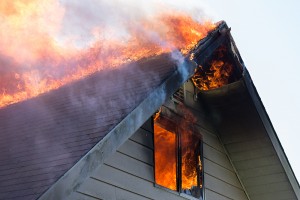
From updating dodgy wiring to fire-resistant siding materials, here’s what to do to keep your home safe
Every year, home fires kill more than 2,500 people and injure another 12,600 (to the tune of an estimated $7.3 billion in property lost!), according to the Department of Homeland Security. And some recent reports note that newer homes, and the furniture in them, ignite faster, due to an abundance of synthetic materials — in everything from carpet backing to upholstery stuffing. (Open floor plans could play a role in fires spreading more quickly too.)
The good news? Fires can be prevented with precautions and fire safety measures, whether you’re looking at homes for sale in Santa Fe, NM, or shopping around for a condo in New York, NY. Here’s what to look out for in your new home, plus steps you can take to minimize fire risk once you move in.
1. Don’t forget the extinguishers
Let’s start with the obvious: Fire extinguishers are an essential defense. When you’re moving in and outfitting your new home, extinguishers may not be on the top of your list, but they should be. Household extinguishers are classified as A, B, or C. The rating denotes what type of fire they work best on — trash/wood/paper (A), flammable liquids (B), or electrical equipment (C). Many home extinguishers are rated all three, and the main distinction is size; choose one that is easiest for you to maneuver. Experiment with using a larger extinguisher so that you’ll be comfortable wielding it in the event of a fire.
To be as safe as possible, you should have one extinguisher in an easy-to-grab spot on every floor. At the very least, have one in the kitchen, where fires are most likely to start, and one in the garage, where flammable materials like oil and gas are kept. Then make note of the expiration dates on all extinguishers and replace or refill them regularly.
2. Confirm smoke alarm installation
In terms of early warnings of fire, a smoke detector alarm is the most critical tool. Laws vary by state, but most newly constructed homes (generally built after 1994) must have hard-wired smoke detectors throughout (battery-operated detectors are permissible for older homes). If you have questions, double-check with your builder or city fire marshal.
Both hard-wired and battery-operated detectors should be tested at least twice a year to make sure the alarms are functional (and the batteries don’t need to be replaced). One easy way to remember? Check your detectors every time you change the clocks for daylight saving time.
3. Check all wiring
According to the National Fire Protection Association (NFPA), about 48% of home electrical fires involve “electrical distribution or lighting equipment.” No doubt, wiring is an important consideration before buying a home. Whether your home is very old, has been recently renovated and you want to get an electrical outlet installation, or is new construction, it’s never a bad idea to hire licensed electrician services or these electricians providing services in Matthews, NC to check all wiring and outlets just to make sure there’s no chance of overload or sparking (preferably before your closing date!). Also check for animal damage outside and around the house — mice and other rodents often chew on electrical insulation. Damaged wires are a fire hazard and need to be replaced by experts like this electrical repair in Ashwaubenon, WI.
4. Keep your fireplace clean (and safe)
There’s nothing better than cozying up to a toasty fire, especially in colder climates, but fireplaces require some know-how. Burning wood creates creosote, which over time builds on the lining of the chimney and can become a fire hazard. Once you move in, get in the habit of scheduling an annual appointment for a chimney cleaning.
Don’t assume you’re safer with a gas fireplace, though. Gas fireplaces are not free from hazards: Those glass coverings can heat up to 400 degrees Fahrenheit and pose a major burn risk for toddlers or pets. If you decide to go with gas, make sure to invest in a screen barrier to go on the outside of the glass. And if it’s not properly maintained by a technician, a gas fireplace can be susceptible to explosions or sudden fires if there is a gas leak or malfunction — so be sure to get it checked annually, preferably by a technician whose company sells the brand you have. If you want to make sure that your gas fireplace is in great condition then consider getting help from a heating contractor to avoid any damages and costly repairs.
5. Take care with space heaters
In those rooms or areas of the home that just don’t seem to warm up, a space heater can be a cozy option — but safety precautions are especially important here; the NFPA attributes one-third of all home heating fires to them. Get an updated model with fire safety features (like a thermostat auto-shut-off feature) and keep it out of the path of kids, pets, and flammable materials.
6. Mind the dryer (and lint trap)
The laundry room should be part of every fire safety inspection. Check that the dryer has a functioning, connected exhaust vent that’s in good shape and not crushed or restricted. And then there’s the lint trap. A clogged one can cause the dryer to overheat and catch fire, so make sure you clean it out after every load.
7. Use more natural materials
Homes constructed many years ago primarily used natural building materials such as wood, plant fiber, metal, and cotton fabric. New-construction homes incorporate more plastic into their building materials and furnishings, and unfortunately, plastic burns more readily and at a higher temperature than natural materials. While it’s not practical, possible, or even sensible to replace all of the potentially flammable building materials in your home, you can choose your decor and furniture — and that can make a big difference in a fire. If possible, try to limit the amount of plastic and synthetic fibers you bring into your home by purchasing wood furniture, cotton drapes and shower curtains, and carpets that meet federal safety guidelines for flammability.
8. Landscape smart
If you’re moving into a newly constructed home, you have a clean slate for landscaping; keep safety in mind when planting. The area around your home should be clear of dead grass and leaves (in California, where wildfires are common, local laws mandate a 100-foot clearance). It’s also good practice to trim branches that hang too low or too close to the home, and choose “fire-wise” plants.
9. Put a safe roof over your head
When looking for a new home or updating an older one, don’t forget the roof. Recommended noncombustible exterior roofing materials include slate, concrete tile, fiberglass, and metal roofing. If you’re building, consider fire safety in your material selection: Roofing materials such as asphalt shingles and wood shakes are less resistant to fire than the aforementioned materials. If you live in an area where wildfires occur, it’s extremely important to have a fire-resistant roof: Burning debris buoyed by heated air and wind can easily land on your house. Don’t give it the opportunity to ignite. You should also learn about the future of sustainable flat roofing projects using Protec Evolve.
A roof replacement provides your property with adequate protection from the elements, and without it, your property can be damaged. Use this contact form to get in touch with roofing experts.
10. Inspect windows and walls
Windows and walls can be key in protecting your home from fire (again, especially if you live in a wildfire-prone area). Most experts recommend fire-resistant house siding material made of brick, plaster, or stucco, and tempered or double-paned glass. Once you’ve moved in, repair or replace any damaged or loose windows and screens too.
And one last tip: Talk to your insurance agent about any fireproofing you do — it might lower your premium so you can recoup some of the costs.
|



Leave a Comment